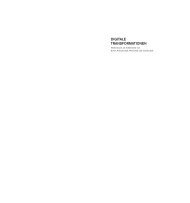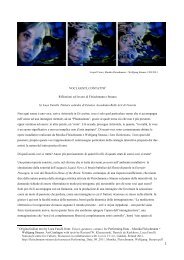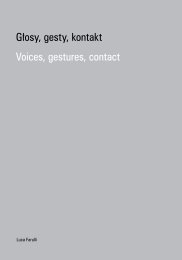Performing Data | Monika Fleischmann + Wolfgang Strauss
Performing Data is a review of Monika Fleischmann´s and Wolfgang Strauss´artistic body of work and a catalogue of their exhibition in Poland 2011. It presents works from Virtual Reality (Home of the Brain) up to Mixed Reality (Murmuring Fields) from Fluid Interface (Liquid Views) up to Floating Interface (Medienfluss) and texts by Ryszard W. Kluszczynski, Derrick de Kerkhove, Luca Farulli. Monika Fleischmann and Wolfgang Strauss from the German Fraunhofer research institute show us an intersection of the body and immaterial digital data. Immersion in data flow causes productive moments of disturbance and suspension, and consequently – a feeling of real physical presence. Fleischmann, Monika; Strauss, Wolfgang: Performing Data | Performowanie danych. National Centre for Culture, Warszawa 2011 in collaboration with Laznia CCArt, Gdańsk, Poland 2011 ISBN 978-83-61587-55-2 (en/pl) http://artline-southbaltic.eu/de/event/performing-data/
Performing Data is a review of Monika Fleischmann´s and Wolfgang Strauss´artistic body of work and a catalogue of their exhibition in Poland 2011. It presents works from Virtual Reality (Home of the Brain) up to Mixed Reality (Murmuring Fields) from Fluid Interface (Liquid Views) up to Floating Interface (Medienfluss) and texts by Ryszard W. Kluszczynski, Derrick de Kerkhove, Luca Farulli.
Monika Fleischmann and Wolfgang Strauss from the German Fraunhofer research institute show us an intersection of the body and immaterial digital data. Immersion in data flow causes productive moments of disturbance and suspension, and consequently – a feeling of real physical presence.
Fleischmann, Monika; Strauss, Wolfgang: Performing Data | Performowanie danych. National Centre for Culture, Warszawa 2011 in collaboration with Laznia CCArt, Gdańsk, Poland 2011 ISBN 978-83-61587-55-2 (en/pl) http://artline-southbaltic.eu/de/event/performing-data/
Create successful ePaper yourself
Turn your PDF publications into a flip-book with our unique Google optimized e-Paper software.
hipertekstualność dominuje w polu poznawczym.<br />
Nacisk położony jest na nawigację<br />
po tej złożonej, lecz zarazem przejrzyście<br />
zdefiniowanej i wyartykułowanej<br />
bazie danych. Ponieważ prawdopodobnie<br />
najlepszym, jeśli nie jedynym sposobem<br />
prezentacji dużej ilości danych na ekranie<br />
jest umieszczenie ich pod hasłami, nasze<br />
umysły niemal przestały być wrażliwe<br />
na narracje, zamiast tego zajmując się –<br />
„adresami”. Żyjemy w erze tagu, obłoku<br />
pojęciowego, totalnego zanurzenia w informacjach<br />
i w rozszerzeniu naszego<br />
poznania w przedłużonej rzeczywistości<br />
Internetu.<br />
<strong>Fleischmann</strong> i <strong>Strauss</strong> kwestionują<br />
przestrzenne ograniczenia spuścizny<br />
renesansu, a także boski przywilej „ja”.<br />
Zarówno przestrzeń, jak i tożsamość są<br />
zbieżnymi i zbiorowymi postaciami wyobrażeń<br />
umysłowych, elementami typowo<br />
zachodniej psycho-zmysłowej syntezy.<br />
„Ja” sytuuje siebie dzięki odniesieniu do<br />
trójwymiarowej rzeczywistości. Jednak<br />
podczas gdy konwencjonalna perspektywa<br />
i trompe l’œil, jak również hologramy<br />
stwarzają spektakl na zewnątrz „ja”<br />
(trompe l’œil oznacza „zmylić oko” – na<br />
podstawie przedstawienia dwuwymiarowego<br />
być przekonanym o jego trójwymiarowości<br />
bez potrzeby upewniania się<br />
przez dotyk), to wirtualna rzeczywistość<br />
oraz interaktywność angażują „ja”, wciągają<br />
je w spektakl i w działanie. Wirtualna<br />
rzeczywistość jest doskonałą technologią<br />
do symulowania doświadczeń umysłowych<br />
innych ludzi, a nawet innych<br />
istot. Dla przykładu Tamas Waliczky badał<br />
wizualną perspektywę czterolatka<br />
w zapadającej w pamięć pracy The Garden<br />
[„Ogród”]. Wirtualna rzeczywistość<br />
divine right of the self. Both space and<br />
self are concurrent and collaborative<br />
forms of mental representation, part<br />
and parcel of the typically western<br />
psycho-sensorial synthesis. The self<br />
positions itself by reference to a 3-D<br />
reality. However, while conventional<br />
perspective and trompe-l’œil as well<br />
as holography today always keep the<br />
self away from the spectacle (trompel’œil<br />
means to “fool the eye” into believing<br />
that it can appreciate the depth of<br />
a 2-D representation without the need<br />
to touch the painting), VR and all interactivity<br />
involve the self, suck it in the<br />
spectacle and into action, so to speak.<br />
Virtual Reality is an excellent technology<br />
to simulate other people’s, and<br />
even other creatures, mental experiences.<br />
Tamas Waliczky, for example,<br />
has explored the visual perspective<br />
of a four-year old in his unforgettable<br />
piece called The Garden. Constitutionally,<br />
VR must always present the rudiments<br />
of a coherent psycho-sensorial<br />
synthesis, by which I mean the combination<br />
of sensory biases and mental<br />
skills typical of one culture or one<br />
generation.<br />
In <strong>Fleischmann</strong> and <strong>Strauss</strong>, what<br />
we are witnessing is the art of people<br />
who have understood that something<br />
really serious is happening when our<br />
literate consciousness is put outside<br />
our minds but with other people’s<br />
thoughts in it. As they judge: “The<br />
game with reality remains the most<br />
important theme when working with<br />
virtual sets.” Like the great novelists<br />
of old, they are explorers and builders<br />
of consciousness. It is likely that







